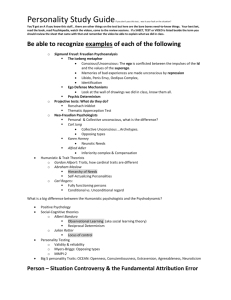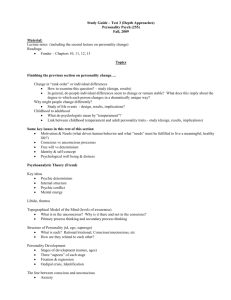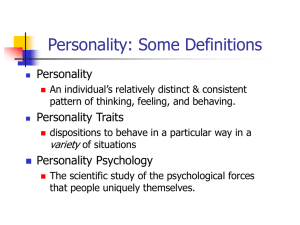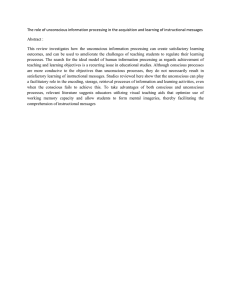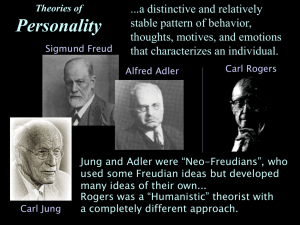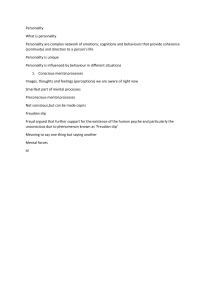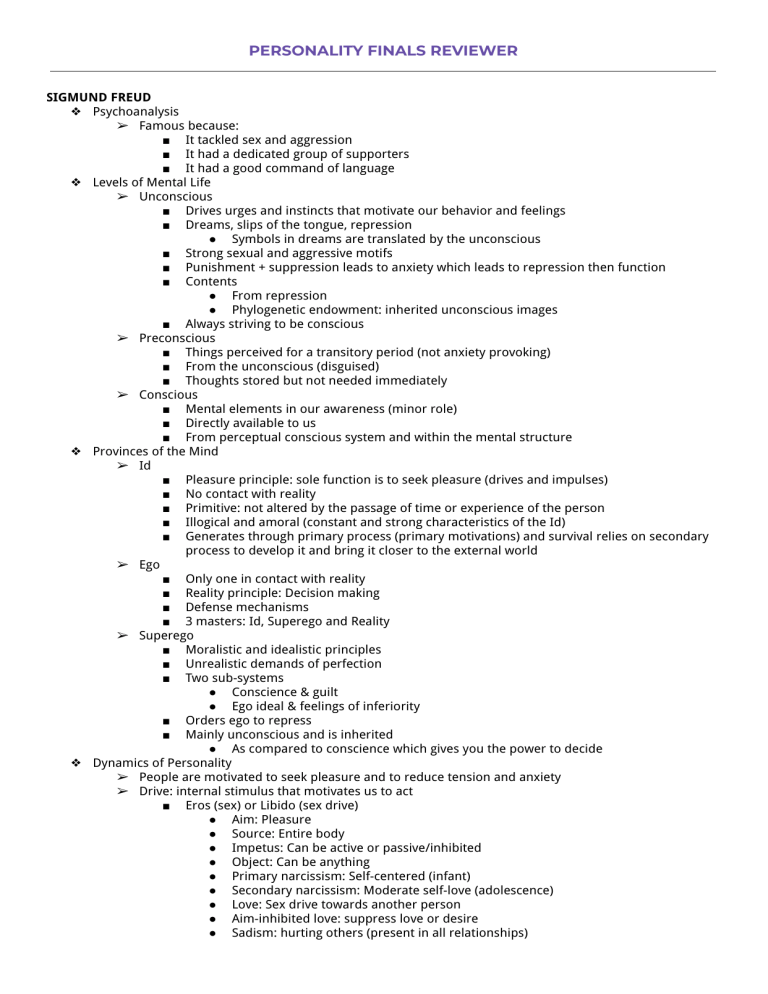
PERSONALITY FINALS REVIEWER SIGMUND FREUD ❖ Psychoanalysis ➢ Famous because: ■ It tackled sex and aggression ■ It had a dedicated group of supporters ■ It had a good command of language ❖ Levels of Mental Life ➢ Unconscious ■ Drives urges and instincts that motivate our behavior and feelings ■ Dreams, slips of the tongue, repression ● Symbols in dreams are translated by the unconscious ■ Strong sexual and aggressive motifs ■ Punishment + suppression leads to anxiety which leads to repression then function ■ Contents ● From repression ● Phylogenetic endowment: inherited unconscious images ■ Always striving to be conscious ➢ Preconscious ■ Things perceived for a transitory period (not anxiety provoking) ■ From the unconscious (disguised) ■ Thoughts stored but not needed immediately ➢ Conscious ■ Mental elements in our awareness (minor role) ■ Directly available to us ■ From perceptual conscious system and within the mental structure ❖ Provinces of the Mind ➢ Id ■ Pleasure principle: sole function is to seek pleasure (drives and impulses) ■ No contact with reality ■ Primitive: not altered by the passage of time or experience of the person ■ Illogical and amoral (constant and strong characteristics of the Id) ■ Generates through primary process (primary motivations) and survival relies on secondary process to develop it and bring it closer to the external world ➢ Ego ■ Only one in contact with reality ■ Reality principle: Decision making ■ Defense mechanisms ■ 3 masters: Id, Superego and Reality ➢ Superego ■ Moralistic and idealistic principles ■ Unrealistic demands of perfection ■ Two sub-systems ● Conscience & guilt ● Ego ideal & feelings of inferiority ■ Orders ego to repress ■ Mainly unconscious and is inherited ● As compared to conscience which gives you the power to decide ❖ Dynamics of Personality ➢ People are motivated to seek pleasure and to reduce tension and anxiety ➢ Drive: internal stimulus that motivates us to act ■ Eros (sex) or Libido (sex drive) ● Aim: Pleasure ● Source: Entire body ● Impetus: Can be active or passive/inhibited ● Object: Can be anything ● Primary narcissism: Self-centered (infant) ● Secondary narcissism: Moderate self-love (adolescence) ● Love: Sex drive towards another person ● Aim-inhibited love: suppress love or desire ● Sadism: hurting others (present in all relationships) ● Masochism: hurting self (present in all relationships) Thanatos (aggression) ● Aim: Destruction or self-destruction ● Teasing, gossip, sarcasm, humiliation ◆ Religion as reaction formation ■ Anxiety ● Unpleasant; warns people of impending danger ● Neurotic anxiety: Apprehension about unknown danger ● Moral anxiety: Conflict between ego and superego ● Realistic anxiety: Unpleasant nonspecific feeling involving a possible danger (fear) ◆ No threat being presented yet but the person is already scared ● Allows ego to protect and preserve itself ❖ Defense Mechanisms ➢ Repression: Unconsciously pushing threatening feelings into the unconscious ➢ Reaction Formation: Disguising an impulse directly opposite its original form ➢ Displacement: Redirecting unacceptable urges to different people or objects ➢ Fixation: Permanent attachment to an earlier psychosexual stage that is more comfortable ➢ Regression: Reverting back to an earlier stage in times of stress ➢ Projection: Attributing unwanted impulses to an external object ➢ Introjection: People incorporate positive qualities of another person in their own ➢ Sublimation: Repression of genital aim by subbing a cultural or social aim ➢ Defense mechanisms are normal and universal ■ If extreme, it is considered to be compulsive, repetitive and neurotic behavior ■ New: Identification is an ego defense or mental mechanism through which an individual, in varying degree, makes himself or herself like someone else; he identifies with another person. ■ ❖ Stages of Development (limited focus on early childhood) ➢ Infantile Stage ■ Most crucial stage ■ Sexual please and autoerotic ■ Oral Phase ● Thumb sucking ● Receptive but sadistic or aggressive ■ Anal Phase ● Aggression and excretion ● Early: Toilet training frustrations ● Later: Erotic, friendly interest towards feces ● Anal character: Keeping, possessing objects (obsessive arranging) ● Anal triad: Orderliness, Stinginess and Obstinacy ● Active orientation: Dominance and Sadism ● Passive orientation: Voyeurism and Masochism ■ Phallic Phase ● Genital area ● Male and female development are different ● Male Oedipus Complex ◆ Identifies with father ◆ Children are bisexual ◆ Sexual desire for mom ◆ Castration Anxiety: Father as a rival and fear of cutting penis off ◆ Oedipus complex is dissolved or repressed ➢ Surrender desire for love and primitive superego ◆ Introjects either parent which further develops superego ● Female Oedipus Complex ◆ View of women that everyone has the same genitals ◆ Penis envy ◆ Identifies with mom (fantasies) ◆ Hostility with mom -> desires for dad ◆ Superego is weaker ◆ Possible outcomes: ➢ Develop normally ➢ Give up sexuality ➢ Cling to masculinity ➢ Latency Period ■ 4-5 years old until puberty ■ Dormant psychosexual development ■ Psychic energy directed towards school, friends, hobbies (sublimation) ■ Phylogenetic endowment ■ Sexual drive is aim-inhibited ● Not acted out ➢ Genital Period ■ Sexual drive is directed to another person ■ Vagina obtains same status as penises ● Vagina is sought after ■ Extends from puberty to adulthood ➢ Maturity ■ Never expounded on by Freud (2018) - talaga ba (08/20/2022) ■ Psychological maturity seldom happens ● People develop pathological disorders or neurotic predispositions ■ Ideal personality; can love without the urgent dependency of the oral character; you can love without trying to possess the other or being overly attached ● Fully potent/work well without the compulsivity of the anal character (without being too perfectionistic) ● Satisfied with the self without the vanity of the phallic character ● Altruistic and generous without the rigidity of the anal character ● Fully socialized, adjusted, but not overly-pained or crippled or constricted by being part of a group or society; he can still be himself somehow ❖ Application of Psychoanalytic Theory ➢ Freud’s early therapeutic technique ■ Suggested parental seduction to his patients ■ Led to development of the Oedipus Complex Theory ■ Learned to adopt a more passive psychotherapeutic technique ➢ Freud’s later therapeutic technique ■ Goal: Uncover repressed memories ■ Strengthen ego to make it more independent of superego and more aware ■ Free Association ● Required to verbalize every thought that comes to their mind ● First word that comes to your mind; might be the reason that the client lays on a couch and does not see the therapists ■ Transference ● Clients transfer their sexual or aggressive feelings from their parents to the therapist ● Unconscious projection from someone in your past to someone in your present ■ Resistance ● Unconscious responses used by patients to block their own progress in therapy ■ Dream Analysis ● Royal road to the unconscious (dreams as wish fulfillment) ● Look at how dreams are formed ● Manifest content: Surface appearance of the dream ● Latent content: Unconscious meaning of dream ● Condensation: Unconscious material has been abbreviated or condensed before appearing on manifest level ● Displacement: Dream replaced by another idea only remotely related to it ● Inhibition/Reversal of affect: Dreaming the opposite of what you actually feel ● Dream Interpretation ◆ Goal: Trace dream formation backward ➢ Ask patients to relate and associate to their dream ◆ Look at dream symbols ● Anxiety Dreams ◆ Wish of the unconscious causes anxiety in the preconscious ◆ Examples: naked dreams, death of beloved person, failing an exam ■ Freudian Slips: mistakes revealing a person’s unconscious intentions ❖ Critique of Freud ➢ Did Freud understand women? ➢ Was Freud a scientist? ■ Theory rated average in ability to generate research ❖ Concept of Humanity ➢ Determinism ➢ Pessimism ➢ Causality ➢ Unconscious ➢ Biological ➢ Uniqueness and Similarities ALFRED ADLER ❖ Individual Psychology ➢ People are born with weak and inferior bodies ■ Feelings of inferiority propel us toward success ■ Infants are small, weak and incomplete ■ Dependence on others ● Social interest is inherent ➢ Tendency to strive for wholeness is innate ❖ Tenets of the Adlerian Theory ➢ The dynamic force behind people’s behavior is striving for success or superiority ■ Physical deficiencies lead to feelings of inferiority ● Striving for Success ◆ Social interest and concern for others ◆ Cooperate with others for social benefit ◆ Social progress > Personal credit ● Striving for Superiority ◆ Little or no concern for others; goal is to gain personal success ◆ Inferiority complex (exaggerated feelings) ◆ Personal credit > Social progress ■ Final Goal ● Personal superiority or success for all mankind ● Unifies personality and makes sense of all behavior ● Goal is not bounded by genetics or environment ● Goal is created through one’s creative power ■ Neglected or Pampered ● Goal is largely unconscious ● Inconsistent behavior ■ Loved or Secured ● Subgoals are conscious ● Consistent behavior ■ Success is an individualized concept and all formulate a definition of it ➢ Subjective perceptions shape behavior and personality ■ We are influenced by our perceptions of reality and our fictions ■ Ideas; expectations of the future ■ No real existence but we act as if they are real ■ Most important fiction; goal of superiority or success ■ Guides behavior and unifies personality ➢ Personality is unified and self-consistent ■ Inconsistent behaviors do not exist ■ Thoughts, feelings and actions are all directed towards a single goal ■ Inconsistent and erratic behavior will make sense once goal is revealed ■ How people operate with unity and self-consistency ● Organ dialect: Body and organs also reveal a personal goal ■ Harmony between conscious and unconscious ➢ Value of all human activity must be seen from the point of view of social interest ■ Gemeinschaftsgefuhl: Social feeling or community feeling ■ Relatedness with humanity ■ Empathy for others ■ Cooperation for social growth ■ Origins: ● Mother-child relationship ◆ Mother has social interest and encourages child to develop the same ◆ Mother has genuine and deep rooted love ● Dad plays an important part in development ◆ Avoid emotional detachment and authoritarianism ◆ Personal superiority, feeling of neglect and possibly a parasitic attachment to the mother ■ Importance of social interest ● Measure of psychological maturity ● Immature people lack social interest ● Not all acts of kindness and charity are motivated by social interest ➢ Self-consistent personality structure develops into a person’s style of life ■ Flavor of person’s life ■ Person’s goal, self-concept, feelings for others and attitude towards the world ■ Unique manner of expression and going through life ■ Psychologically healthy people are flexible and diverse ● Expresses social interest through action ● Faces problems through cooperation, courage and willingness to make a contribution to the welfare of another person 3 major problems in life ● Neighborly love ● Sexual love ● Occupation ➢ Style of life is molded by one’s creative power ■ Freedom to create one’s own style of life ■ Create own final goal and decide how we will achieve it ■ We are architects of our own lives ● What matters is not what people have been given but how they use the items Abnormal Development ➢ Underdeveloped social interest ➢ Neurotics tend to: ■ Set goals too high ■ Live in own private world ■ Have a rigid and dramatic lifestyle Factors that Contribute to Abnormality ➢ Exaggerated Physical Deficiencies ■ Causes abnormalities when it is accompanied by accentuated feelings of inferiority ■ Overly concerned with themselves ■ Fear prevents them from desiring success ■ Selfish manner of solving problems ➢ Neglected Style of Life ■ Underlying feelings of being unloved or unwanted ■ Low self-confidence + distrustful ■ Envious of others ➢ Pampered Style of Life ■ Weak social interest ■ Parasitic relationship with parents ■ Unloved and neglected Safeguarding Tendencies ➢ Project exaggerated self-esteem from humiliation ➢ Can be conscious (neurotic style of life) ➢ Excuses ■ Deceives people into thinking they are more superior ■ Projects weak but inflated sense of worth ➢ Aggression ■ Protect fragile self-esteem ■ Depreciation: Undervaluing work of others and overvalue that of self ■ Accusation: Blaming others ■ Self-accusation: Blaming self to guilt trip others ➢ Withdrawal ■ Impedes personality development ■ Safeguarding through distance ■ Moving backward: Revert to old styles ■ Standing still: Avoid responsibilities ■ Hesitating: Procrastinate action until the moment one can say and settle for “ It’s too late” ■ Constructing obstacles: Making own obstacles just to get over them and make self feel better; does not go until the end Masculine Protest ■ ❖ ❖ ❖ ❖ ➢ Artificial overemphasis on being manly that stemmed from social and cultural practices ➢ Males and females are essentially the same ❖ Applications of Individual Psychology ➢ Family Constellation ■ Birth order; gender of siblings and age spread among them ■ Clients are asked about what they think of the situation they were born in ➢ Early Recollections ■ Early memories that give clues regarding patients’ style of life ■ Objective reality or complete fantasies ■ Clues to final goal and present style of life ■ Early recollections have no causal effects with style of life ➢ Dreams ■ Clues in solving problems ■ Everything can be different ● Be open to reinterpretations ■ Most are self-deceptions; disguised to deceive the dreamer ● More prone if goals are inconsistent with reality ➢ Psychotherapy ■ Psychopathology: Lack of courage and feelings of inferiority and underdeveloped social interest ■ “What would you do if I cured you immediately?” ● Forced patients to think of their goals ■ What you do with what you have is more important than what you have ■ Adler’s method: Humor and warmth + friendly and permissive ❖ Related Research ➢ Early recollections and career choice ■ Type of memory is related to career interest ■ Reflects an individual’s personality (Kasler & Nevo 2005) ➢ Early childhood and health-related issues ■ Theory of inferiority, superiority and social feeling can be applied to understand health related behavior ■ Early childhood experiences are less important than adult’s view ➢ Early recollections and counseling outcomes ■ Successful counseling is related to changes in early recollections ■ Theme, character, setting, amount of detail and level of affect ❖ Concept of Humanity ➢ Free choice ➢ Optimism ➢ Teleology ➢ Unconscious and Conscious ➢ Social factors ➢ Uniqueness CARL JUNG ❖ Analytical Psychology ❖ Jungian Ego ➢ Only in touch with what is conscious ➢ No relationship with unconscious elements ➢ Center of consciousness is not necessarily the core of personality ➢ Takes secondary position to the unconscious self ■ You are psychologically healthy if you are in touch with your unconscious ❖ Jungian Unconscious ➢ Collective Unconscious ■ Inherited from previous generations and passed on ■ Similar to people in different cultures ■ Influences thoughts, emotions and actions ■ Archetypes ➢ Personal Unconscious ■ Repressed, forgotten or subliminally perceived event and experiences of an individual ■ Unique ■ Contains complexes ● Emotionally toned association of ideas ● Can be partly conscious and unconscious ❖ Archetypes ➢ Images from the collective unconscious ➢ Persona ■ Personality you show the world ■ Public self = complete self ■ Psychologically healthy people balance public self to true self ➢ Shadow ■ Qualities we have that we deny and hide from others ■ Seeking to know our shadow is our first test of courage ➢ Anima ■ Feminine side of men from collective unconscious ● Early ancestors’ experiences with women ■ The “feeling”side of a man (moody and irrational) ■ Acknowledging anima is the second test of courage ➢ Animus ■ Masculine archetype in women ■ Thinking and reasoning ➢ Great Mother ■ Derived from anima ■ Loving and terrible ■ Fertility, nourishment and destruction ■ We project this to our own mothers ➢ Wise Old Man ■ Wise and arrogant ■ Impressive, captivating and hollow ■ Derived from animus ➢ Hero ■ Powerful and vulnerable ■ Able to overcome several challenges ■ Defeated by seemingly insignificant person, object or event ● Tragic flow ➢ Self ■ Archetype of archetypes ● Unites all archetypes ● Self-realization ■ Innate tendency to move toward growth, balance, completion and wholeness ■ Never fully balanced ■ Symbolized by mandala ❖ Dynamics of Personality ➢ Causality and teleology ■ Behavior caused by both ■ Dreams ● Past events ● Solutions for the future ➢ Progression and regression ■ Progression: Forward flow of psychic energy ● Understanding the outer world ■ Regression: Backward flow of psychic energy ● Understanding the inner world ■ Achieve growth and self-realization ❖ Psychological Types ➢ Attitudes ■ Tendency or predisposition to act in a certain way ■ Introversion: Biases, feelings and perception (subjective) ■ Extraversion: Events in surroundings (objective) ➢ Functions ■ Thinking ● How people develop meaning for what they see ● Logical and intellectual ■ Feeling: How we come to know value and worth ■ Sensing: How we know something exists ■ Intuiting: Sensing things not in consciousness ❖ Development of Personality ➢ Childhood ■ Anarchic: chaotic ■ Monarchic: development of ego, logical and verbal thinking ■ Dualistic: development of objective and subjective worlds (outer and inner) ➢ Youth ■ Puberty until middle life ■ Increased activity, sexual maturation, growing consciousness ■ Conservative principle: Natural tendency to cling to childhood ➢ Middle Life ■ Begins at 35-40 years old ■ Increasing anxieties ■ Full of potentials ■ Need to develop new values and ideas ■ Moving into an introverted direction ➢ Old Age ■ Dimming of consciousness ■ Fear of death ■ Death makes life more meaningful ❖ Individuation ➢ Self-realization ➢ Becoming whole by integrating opposites ➢ Coming to terms with unconscious ➢ Difficult ➢ Balance of both conscious and unconscious selves ❖ Methods ➢ Word Association Test ➢ Dreams ➢ Active Imagination ■ Accessing dream world while awake (drawing or painting) ➢ Psychotherapy ■ Confessions of a pathogenic secret ■ Interpretation, explanation, elucidation ■ Education about the social nature ■ Transformation (hard to meet) ❖ Related Research ➢ Personality type and investment ➢ Personality type and engineering ❖ Concept of Humanity ➢ Neither pessimistic nor optimistic ➢ Neither deterministic nor purposive (free choice) ➢ Partly conscious and partly unconscious ➢ Both causal and teleological ➢ More biological than social ➢ Similarities rather than individual differences ERIK ERIKSON ❖ Psychosocial Development Theory ❖ Post-Freudian Theory ➢ Extension of Freud’s developmental stages ➢ Each stage there is a psychological or psychosocial struggle ■ Personality formation ➢ Identity crisis: turning point ➢ Emphasized social and historical influences ❖ Erikson’s Ego ➢ Center of our personality, “I” ➢ Helps us adapt to outside challenges ➢ But also prevents us from losing our individuality ➢ Partially unconscious ➢ Has force and energy of its own ❖ Three Aspects of the Ego ➢ Body Ego ■ Experiences with your body ■ The way we perceive our body ■ Realization: this is the only body we have ➢ Ego Ideal ■ Comparison of ourselves to the ideal self ■ Accounts for satisfaction and dissatisfaction ➢ Ego Identity ■ Different social roles that we have ❖ Society’s influence in Personality Development ➢ Ego emerges from society and is shaped by practices of that society ■ Erikson visited different tribes and looked at how they were raised ❖ How does personality develop from one stage to the next? ➢ Epigenetic Principle ■ Stages in which you develop body parts ■ Ego develops in a predetermined rate and fixed sequence ■ New stages emerge and build on previous stages ❖ Stages of Psychosocial Development ➢ Interaction of opposites (Both experiences are necessary) ■ Syntonic: Harmonious ■ Dystonic: Disruptive ➢ Produces ego strength = Basic Strength ■ If not formed, Core Pathology develops ➢ Ego is shaped by multiple conflicts and events in past, present and future ➢ Identity crisis is present from adolescence onward ■ Opportunity for adaptive or maladaptive changes Psychosocial Stage Age Basic Strength Core Pathology Psychosexual Mode Significant Relations Trust vs. Mistrust Infancy Hope Withdrawal Oral- Respiratory - Sensory Kinesthetic The mothering one Autonomy vs. Shame Early Childhood Will Compulsion Anal - Urethral Muscular Parents Initiative vs. Guilt Play Age Purpose Inhibition Infantile genital locomotor Family Industry vs. Inferiority School Age Competence Inertia Latency Neighborhood and School Identity vs. Identity Confusion Adolescence Fidelity Role Repudiation Puberty Peer groups Intimacy vs. Isolation Young Adult Love Exclusivity Genitality Sexual partners and friends Generativity vs. Stagnation Adulthood Care Rejectivity Procreativity Divided labor and shared household Integrity vs. Despair Old Age Wisdom Disdain General of sensual modes All humanity ❖ Erikson’s Method ➢ Psychohistory ■ Psychoanalytic study of historical figures ■ Method to prove a person is a product of his/her historical time ■ Culture/society shapes you ❖ Related Research ➢ Generativity and Parenting ■ High generativity ● Greater effort and care in raising child ● Child is happier and well-adjusted and optimistic about the future ➢ Generativity vs. Stagnation = Opposite poles ❖ Concept of Humanity ➢ Neither deterministic nor purposive ➢ Optimistic ➢ Causal ➢ Conscious (after adolescence) and Unconscious (before adolescence) ➢ Social ➢ Unique KAREN HORNEY ❖ Psychoanalytic Social Theory ➢ Personality is shaped by sociocultural conditions and childhood experiences ➢ Unloved children develop basic hostility which leads to basic anxiety ➢ People combat anxiety by moving toward, against and away from people ❖ Horney’s Criticism of Freud’s Theory ➢ Freud’s psychoanalytic theory would lead to stagnation ➢ Freud’s ideas on feminine psychology are inferior and have a weak ego ➢ Move beyond instinct theory and emphasize cultural differences ❖ What Shapes Personality ➢ Impact of Culture ■ Our culture is based on competition among individuals ■ Basic Hostility: becoming angry at the world ■ Basic Anxiety: Feelings of isolation; permeates all relationships; unhealthy ways to cope ■ Competition -> BH -> BA -> Intensified Needs for Affection ● Genuine Love vs. Desperate Need for Love (continues the cycle) ■ Culture teaches value of humility and relationships but promotes attitudes of aggression and superiority ■ Endless demands for success ■ Society says you can accomplish anything you want ● Reality: You are restricted by your genes, social position and competitiveness of others ➢ Importance of Childhood Experiences ■ Stage where most problems arise ■ Lack of genuine warmth and affection from parents leads to negative experiences ■ Favorable conditions for healthy development ● Warm and loving (genuine love) ● Not overly permissive (healthy discipline) ● Leads to feelings of safety and satisfaction ● Allows one to grow and be his real self ❖ Defenses Against Basic Anxiety ➢ Affection ■ Does not always lead to genuine love ■ Some people may try to purchase love ➢ Submissiveness ■ Compliance to a person or an organization to gain affection ➢ Striving for Power, Prestige or Possession ■ Power: Dominating others to protect self from hostility ■ Prestige: Humiliating others to protect self from humiliation ■ Possession: Depriving others to protect self from poverty ➢ Withdrawal ■ Emotional detachments from others ■ They feel like they cannot be hurt by others ➢ Compulsive Drives ■ Pattern of repeating defensive mechanisms ❖ Neurotic Needs ➢ Affection and Approval ■ Person pleases others (need for approval) ■ Peacemakers ➢ Powerful Partner ❖ ❖ ❖ ❖ ❖ ❖ ■ Lacks confidence and finds someone to cling to ➢ To Restrict One’s Life with Narrow Borders ■ Strive to remain inconspicuous; downgrade abilities ➢ Power: Control others to avoid feeling weak ➢ Exploiting Others ■ See others as what they can use from them to avoid being exploited themselves ➢ Social Recognition or Prestige ■ Want to be on top; attract attention to selves ➢ Personal Admiration: Admired for what they are rather than what they possess ➢ Ambition and Personal Achievement ■ Be the best in everything (superiority) ➢ Self-Sufficiency and Independence ■ Need to move away from people ➢ Perfection and Unassailability ■ Dread making mistakes and having personal flaws Neurotic Trends ➢ Moving Toward People ■ Friendly and loving vs. Compliant personality ■ Solves basic conflict of helplessness (morbid dependency) ■ Willing to subordinate to others ➢ Moving Against People ■ Survivor vs. Aggressive personality ■ Solves basic conflict of hostility ■ Appear tough, ruthless and perfect/superior but exploits others ➢ Moving Away from People ■ Autonomous and serene vs. Detached personality ■ Solves basic conflict of isolation ■ Compulsively distancing selves from others; aloof, self-sufficient and detached Intrapsychic Conflicts ➢ Within self (interpersonal experiences) ➢ Becomes part of person’s belief system (both normal and neurotic) ➢ Idealized Self-Image ■ Desperately needing to acquire a stable sense of identity; present in a warm environment ■ Creates an idealized self-image and believes it is real ■ Neurotic Search for Glory ● Need for perfection (should do) ● Neurotic ambition: best in everything/vindictive triumph ■ Neurotic Claims ● Build an idea of a world where they are special and entitled ■ Neurotic Pride ● Protect and support glorified view of self (not genuine) ➢ Self-Hatred ■ Neurotics come to hate themselves ■ Expressions ● Relentless demands on self ● Merciless self-accusation ● Self-contempt, self-frustration, self-torment and self-destructive actions & impulses Feminine Psychology ➢ Culture and society cause gender differences ➢ Oedipus complex is not universal ➢ Child’s main goal is security Psychotherapy ➢ Goal: Help patients move toward self-realization (Dream Interpretation and Free Association) ➢ Give up idealized self, a neurotic search for glory and turn hatred to acceptance Critique of Horney ➢ Rich description of neuroticism but not about healthy individuals ➢ Did not define what self-realization means ➢ Did not generate much research ➢ Terms are used inconsistently Concept of Humanity ➢ Free choice ➢ Optimistic ➢ Causality and Teleology ➢ Conscious and Unconscious ➢ Social Influences ➢ Similarities ➢ ABRAHAM MASLOW ❖ Holistic Dynamic Theory ➢ People as a whole are constantly motivated by one need or another ➢ People have potential to grow toward self-actualization (psychological health) ➢ Part of humanistic or existential theories (Third Force) ➢ Main focus is knowing what makes people psychologically healthy ❖ Assumptions about Motivation ➢ Holistic approach ➢ Motivation is complex (several motives; may be unconscious) ➢ People are continually motivated by one need or another ➢ Everyone is motivated by the same basic needs ❖ Maslow’s Hierarchy of Needs ➢ Physiological ■ Only need that can be completed and even overly satisfied (recurring) ➢ Safety ■ Cannot be completely satisfied ■ Basic anxiety: results from inability to satisfy safety needs ➢ Love and Belongingness ■ When satisfied: Stable, confident and secured ■ Never experienced: Incapable of giving love and devalues love ■ Small doses: Strongest needs to feel loved and accepted ➢ Esteem ■ Reputation: Your perception of how others rate your prestige and fame ■ Self-esteem: Own feeling of worth and confidence ➢ Self-Actualization ■ Self-fulfillment: Realization of full potential ■ Independent from lower needs ■ Embrace B-Values ■ Deprivation leads to metapathology ● Absence of values, lack of fulfillment and loss of meaning in life ❖ Other Needs (Conative Needs) ➢ Aesthetic ■ Not universal but there are traces in different cultures ■ Individuals become ill when needs are not met ➢ Cognitive ■ Hard to satisfy conative needs if this is blocked ■ Skeptical, disillusioned and cynical ➢ Neurotic ■ Can lead to stagnation and pathology whether satisfied or no ■ Non-productive ■ Reaction and a compensation to an unsatisfied basic need ❖ Types of Behavior ➢ Expressive: Usually unconscious and unmotivated ➢ Coping: Consciously effortful and motivated by a deficit need (learned) ❖ Maslow’s Dilemma: Wanted to know what makes people self-actualize ❖ Criteria for Self-Actualization ➢ Free from psychopathology ➢ Progressed through hierarchy of needs ➢ Embraced B-Values ➢ Fulfilled needs to grow, develop and increasingly become what they are capable of becoming ❖ Being Values ➢ Effortlessness ➢ Humor ➢ Autonomy ➢ Truth ➢ Goodness ➢ Beauty ➢ Wholeness ➢ Aliveness ➢ Uniqueness ➢ Perfection ❖ Measuring Self-Actualization ➢ Everett Shostrom and the Personal Orientation Inventory ➢ 150 forced choice items ❖ The Jonah Complex ➢ Another block to self-actualization ➢ Fear of being one’s best; running away from one’s destiny ❖ Psychotherapy ➢ Embrace B-Values ➢ Free dependency from others ➢ Guide towards self-actualization (interpersonal) ❖ Concept of Humanity ➢ Optimistic ➢ Uniqueness and Similarities ➢ Teleological ➢ Deterministic and Free Choice ➢ Conscious and Unconscious ➢ Biological and Social Influence CARL ROGERS ❖ Person-Centered Theory ❖ Assumptions ➢ Formative Tendency ■ All matter evolves from simpler to complex forms ■ Life is a creative process not a disintegrative one ➢ Actualizing Tendency ■ Innate tendency in all humans to move toward completion and to fulfill potentials ■ Maintenance Needs: Basic needs and tendency to resist change ■ Enhancement Needs: Willingness to learn new things ❖ Conditions Necessary Actualize ➢ Have a relationship that is congruent and authentic with someone who demonstrates empathy and unconditional positive regard ❖ Self-Actualization ➢ Subset of actualization tendency ➢ Tendency to actualize the self you perceive ➢ Tension arises when your perceived self is in contradiction with your actual experience ❖ Subsystems of the Self ➢ The Self-Concept ■ Includes all aspects of yourself and your experience that you are aware of ■ May not always be accurate ■ Not equal to organismic self ■ Established self-concept makes change difficult ➢ The Ideal Self ■ One’s view of self as one wishes to be ■ Attributes you want to possess ■ Wide gap between ideal self and self concept creates incongruence ❖ Levels of Awareness ➢ Ignored or Denied ■ Things you are not aware of ➢ Accurately Symbolized ■ Non-threatening ■ Consistent with and freely admitted to self concept ➢ Distorted ■ When experience is not consistent with our view of self we reshape or distort it ■ Not only bad experiences are distorted ❖ Becoming a Person ➢ Person interacts with another person -> Need for positive regard -> Positive self-regard ➢ Love from others leads to love for self ❖ Barriers to Psychological Health ➢ Conditions of Worth ■ When acceptance and love are only given when they meet people’s expectations and approval ■ We assimilate these standards and also judge ourselves ■ Separates us from our organismic self ➢ Incongruence ■ Difference between the organismic self and the self-concept ■ Vulnerability: people are unaware of their incongruence ■ Anxiety and Threat: when we become aware of the incongruence ➢ Defensiveness ■ Protecting self-concept against anxiety and threat by: ● Distortion: Misinterpret an experience for it to fit in our experience ● Denial: Refuse to perceive experience ➢ Disorganization ■ Defenses failed and behavior becomes psychotic ■ Incongruence becomes too obvious to too sudden ❖ Psychotherapy ➢ Conditions ■ Counselor Congruence ● To be what one truly is ● Being real and genuine, whole and integrated ■ Unconditional Positive Regard ● Warm, positive, accepting and non-possessive ● Without evaluations and restrictions ■ Empathetic Listening ● Temporarily living in the other’s life, moving about in it delicately without making judgments ➢ Process ■ Stage 1: Unwillingness to communicate ■ Stage 2: Less rigid and discuss external events ■ Stage 3: Talks about self but avoids the present ■ Stage 4: Talks about deep feelings but still avoids present ■ Stage 5: Talks about present feelings; growth and discovery about self ■ Stage 6: Allows self to become aware of distorted and denied experiences ■ Stage 7: Becomes a person of tomorrow ➢ Outcomes ■ Rogers’ Theory of Therapeutic Change ● Vulnerable or anxious client ● Contacts a counselor who possesses ◆ Congruence in the relationship ◆ Unconditional positive regard for the client ◆ Empathetic understanding for client’s internal frame for reference ● Client perceives conditions as the three necessary and sufficient conditions for therapeutic growth ● Therapeutic change occurs and the client will: ◆ Become more congruent ◆ Be less defensive ◆ Become more open to experiences ◆ Have a more realistic view of the world ◆ Develop positive self-regard ◆ Narrow gap between ideal self and real self ◆ Be less vulnerable to threat ◆ Become less anxious ◆ Take ownership of experiences ◆ Become more accepting of others ◆ Become more congruent in relationships with others ❖ The Person of Tomorrow ➢ More adaptable ➢ Open to experience ➢ Live fully in the moment ➢ Harmonious relations with others ➢ More integrated ➢ Basic trust of human nature ➢ Enjoy greater richness of life ❖ Concept of Humanity ➢ Free choice ➢ ➢ ➢ ➢ ➢ Optimistic Teleology Uniqueness Conscious Social Influences BF SKINNER ❖ Behavioral Analysis ➢ Focus is on observable behavior ■ Still valued internal behavior ➢ Radical Behaviorism ■ Avoidance of hypothetical constructs ➢ Determinist: No free will ➢ Environmentalist: Behavior can be explained by looking at environmental stimuli ❖ Precursor to Skinner’s Behaviorism ➢ Thorndike’s Law of Effect ■ Response -> Satisfier -> Response is “stamped in” ■ Response -> Annoyer -> Response is inhibited ➢ John B. Watson ■ Consciousness and introspection have no place in science ■ Psychology: Prediction and control of behavior ❖ Skinner ➢ Internal mental factors exist but what should be done is to study the observable physical events that give rise to it ➢ Classical Conditioning (Respondent Conditioning) ■ Phobias, fears and anxieties ■ Little Albert ➢ Operant Conditioning (Skinnerian Conditioning) ■ Behavior, reinforcement, increase in behavior ■ Shaping: Rewarding successive approximations until actual desired behavior is met ■ Stimulus Generalization: Response to similar environment in the absence of previous reinforcement ■ Reinforcement ● Strengthens behavior ● Rewards person ● Positive reinforcement: Added stimulus ● Negative reinforcement: Removal of aversive stimulus ● Consequence = Operant discrimination: Reacting to some elements in our environment but not to others ■ Punishment ● Suppresses behavior ● Conditioning of a negative feeling; presentation of aversive stimulus ● Spreading effects ■ Schedules of Reinforcement ● Continuous ● Intermittent ◆ Fixed or Variable ◆ Ratio (# of responses) or Interval (time period) ❖ Reasons Why Responses are Lost ➢ Forgetting ➢ Interference of previous or new learning ➢ Suppressed due to punishment ➢ Extinction ■ Progressive weakening because it is not reinforced ❖ Development of Human Personality ➢ Natural Selection: Behavior that is beneficial to the species will survive ➢ Cultural Evolution: Cultural practices that are beneficial to the species will survive ➢ Inner States ■ Self-awareness + purpose & intention ■ Drives: Do not cause behavior but serve as explanatory fictions ■ Emotions: Effect of reinforcement ➢ Complex Behavior ■ Higher mental processes: thinking, problem solving and reminiscing ■ Creativity: Random or accidental conditions are produced ■ Unconscious behavior: Suppressed through punishment ■ Dreams: Covert and symbolic forms of behavior ❖ Control of Human Behavior ➢ Rules and laws (social control) ➢ Each of us is controlled by: ■ Operant conditioning ■ Describing contingencies ■ Deprivation and satiation ■ Physical restraint ❖ Unhealthy Personality ➢ Counteracting strategies ■ Escape: Withdraw from controlling agent ■ Revolt: Counterattacking the controlling agent ■ Passive Resistance: Stubbornness ❖ Psychotherapy: Main block in psychology’s attempt to become a science ❖ Concept of Humanity ➢ Deterministic ➢ Optimistic ➢ Causality ➢ Unconscious ➢ Social Influences ➢ Uniqueness ALBERT BANDURA ❖ Social Cognitive Theory ➢ Basic Assumptions ■ Plasticity: Flexibility to learn even vicariously ■ Triadic reciprocal causation model ■ Agentic perspective ■ Moral agency ❖ Observational Learning ➢ People learn even without performing any behavior ➢ We learn by observing others ➢ Reinforcement is not facilitative but not necessary ➢ Modeling ■ Core of observational learning ■ Adding or subtracting; generalizing ■ People are more likely to model behavior if: ● Person is of high status, is competent and powerful ● People themselves lack status, skill or power ● Behavior is valuable and rewarding or if there is severe punishment ➢ Processes Governing Observational Learning ■ Attention ● More likely to pay attention to people we see (attractive and popular) ■ Representation ● Turning observation into imagery or verbal instruction ■ Behavioral Production ● Rehearsing the behavior and monitoring self ■ Motivation ● Facilitates performance ❖ Enactive Learning ➢ Learning that occurs when behavior is followed by consequences ➢ For complex behaviors ➢ Allows us to think about and evaluate the consequences of our behavior ➢ Allows us to control behavior ❖ Triadic Reciprocal Causation ➢ Environmental Factors ■ Structure of surroundings, presence of reinforcers ■ Chance encounters and fortuitous events (unexpected/unintended) ➢ Personal Factors ■ Memory, anticipation, planning, judging, gender, social position, physical attributes ➢ Behavioral Factors ❖ Human Agency ❖ ❖ ❖ ❖ ❖ ❖ ➢ Capacity to control our own lives; essence of humanness ➢ People are self-regulating, pro-active, self-reflective and self-organizing ➢ Core Features ■ Intentionality: Planning and commitment to actions ■ Forethought: Anticipate outcomes ■ Self-reactiveness: Motivate and regulate actions ■ Self-reflectiveness: Examine and evaluate own self; self-efficacy Self-Efficacy ➢ Belief of whether one can or cannot do a particular behavior or change their environment ➢ Affect person’s actions, effort, perseverance in tasks and resiliency during setbacks ➢ Personal factor ➢ What contributes to self-efficacy? ■ Mastery experiences: Successful past experiences ■ Social modeling: Vicarious experiences affect self-efficacy ■ Social persuasion ■ Physical and emotional states Proxy Agency ➢ Relying on other people to accomplish some goals ➢ May weaken sense of personal or collective efficacy ■ Collective Efficacy: People’s shared belief in their collective power to produce results Self-Regulation ➢ Reactively attempt to reduce discrepancies between their accomplishments and their goal ➢ Proactively set newer and higher goals ➢ What contributes to self-regulation? ■ Limited ability to manipulate external factors that feed reciprocal paradigm ■ People capable of monitoring own behavior ➢ External Factors ■ Environmental factors ■ External standards ■ Reinforcement and sanctions ➢ Internal Factors ■ Personal factors ■ Self-observation: Monitor own performance ■ Judgmental processes ● Personal standards: Monitor self without comparing ● Standard of reference: Set standard one bases performance on ● Performance attribution: Judge causes of behavior ■ Self-reaction: Response to own behaviors Dysfunctional Behavior ➢ Depression ■ Self-Observation ● Exaggerate past mistakes ● Minimize accomplishments ■ Judgmental Processes ● Standard s are unrealistically high ■ Self-Reaction ● Judges self harshly and treats self badly for shortcomings ➢ Phobias ■ Vicarious trauma due to television and media ■ Avoidant behavior is maintained because it is negatively reinforcing ➢ Aggression ■ Positive reinforcement: They enjoy it ■ Negative reinforcement: Avoid consequences by being aggressive ■ Others are rewarded for aggressive acts Self-Regulation through Moral Agency ➢ Doing no harm to people and proactively helping others ➢ Selective Activation: Self-regulation is not automatic ➢ Disengagement of Internal Control: Separate selves from consequences of their behavior ➢ Redefine behavior ➢ Disregard or distort consequences of behavior ➢ Dehumanize and blame victims ➢ Displace or diffuse responsibility Therapy ➢ Goal is self-regulation ➢ Approaches ■ Vicarious Learning ■ Cognitive Modeling ■ Enactive Mastery ❖ Concept of Humanity ➢ Optimistic ➢ Social Influences ➢ Freedom ➢ Causality and Teleology ➢ Conscious ➢ Uniqueness GORDON ALLPORT ❖ Psychology of the Individual ➢ Uniqueness of the individual ➢ Vs. Trait theorists, vs. Nomothetic methods ➢ Morphogenic science: in-depth study of a single person ➢ Eclectic approach (broad) ❖ What is Personality? ➢ Dynamic organization within the individual of those psychophysical systems that determine his characteristic behavior and thought ➢ Human beings are both a product and a process ❖ What is the role of conscious motivation? ➢ Healthy adults are generally consciously aware of motivation ➢ Accept things at face value ❖ What are the characteristics of a healthy person? ➢ Extension of the sense of self ➢ Warm relating of self to others ➢ Emotional security/self-acceptance ➢ Realistic perception ➢ Insight and humor ➢ Unifying philosophy of life ❖ Personal Dispositions ➢ Generalized neuropsychic structures peculiar or unique to the individual ■ With capacity to render stimuli ➢ Different from common traits ■ General characteristics held in common by many people ➢ 17,953 descriptive words (traits, state, evaluative characteristic, physical characteristic) ❖ Levels of Personal Disposition ➢ Most central -> Most peripheral ➢ Cardinal Dispositions: Eminent characteristic or ruling passion ➢ Central Dispositions: 5-10 most outstanding characteristic focused on ➢ Secondary Dispositions: Less conspicuous but great in number ❖ Motivational and Stylistic Dispositions ➢ Since personality is dynamic, all dispositions have motivational power ➢ Motivational Dispositions can be intensely experienced ➢ Stylistic Dispositions: Lesser motivational power but they guide action ❖ Proprium ➢ Behaviors and characteristics that people regard as very central to their being ➢ Crucial to person’s sense of self ❖ Motivation ➢ We are motivated by our present drives ➢ We are aware of what we are doing ➢ We have an understanding of why we are doing it ➢ Peripheral Motives: Reduce a need ➢ Propriate Strivings: Maintain tension and disequilibrium ➢ Theory of Motivation ■ Other previous theories are simply reactive ■ People not only react to the environment but also shape it (Proactive) ➢ Functional Autonomy ■ Some human motives are functionally independent from the original motive responsible for the behavior; other motives are unconscious ■ Conscious, self-sustaining, contemporary systems ➢ Levels of Functional Autonomy ■ Preservative Functional Autonomy ● Tendency of an impression to leave an influence on subsequent experience ● Examples: Rat running through maze, alcohol and drugs ■ Propriate Functional Autonomy ● Master system that confers unity * A present motive is functionally autonomous to the extent that it seeks new goals ❖ Concept of Humanity ➢ Optimistic ➢ Limited freedom ➢ Teleological ➢ Consciousness ➢ Individual differences and uniqueness *Deep religious commitment = maturity Prepared by: Bianca Agbayani BS PSY 2018
